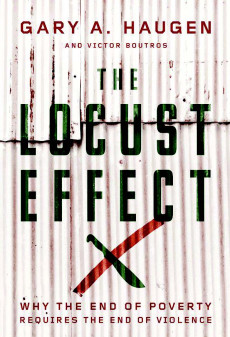
The Locust Effect: Why the End of Poverty Requires the End of Violence
Gary A. Haugen & Victor Boutros
368 pages, Oxford University Press, 2014
Imagine that half of the little girls (and three-fifths of the adult women) you meet have been raped or molested in their home, school, or church, or in some other place where they should be safe. Imagine that one-fifth of the boys you meet have been molested as well. Imagine that your pleasant, easy-going gardener has just had his land and his entire life savings stolen by a local strongman. Imagine that the workers in the brick factory down the hill are slaves who work without pay and under the constant threat of being beaten or raped. Now imagine that the police are so corrupt that they not only fail to stop such abuses, but actually abet these and other crimes.
That’s the reality faced by a large portion of the global poor. And that’s the disturbing picture that Gary Haugen and Victor Boutros paint in The Locust Effect—an indispensable book that urges readers to confront the “massive epidemic of sexual violence, forced labor, illegal detention, land theft, assault, [and] police abuse” that strikes poor people throughout the developing world and prevents them from escaping poverty.
In the developed world, too, the poor suffer from violence in a way that is disproportionate to any threat faced by more affluent people. In 2000, researchers surveyed poor children in the Los Angeles Unified School District and found that 90 percent of them either had been victims of a felony-level act of violence or had witnessed such an act. In many of these kids, moreover, there were signs of serious long-term distress: 32 percent of them showed symptoms of post-traumatic stress disorder, and 16 percent showed symptoms of depression. (To put those figures in perspective: US veterans of the Iraq war exhibit the same symptoms at roughly comparable rates.) But, as Haugen and Boutros make vividly clear, the violence experienced by the American poor pales in comparison with the uncontrolled mayhem that poor people elsewhere suffer. Like a plague of locusts, the lawless violence that festers in the developing world destroys everything in its wake.
Ultimately, it’s not fetid water, rundown shacks, unpaved roads, or empty pantries that make global poverty such an intractable problem. It’s the hidden nightmare of violence that we in the developed world do not see. Advocates have rallied on many fronts to combat poverty. And yet, Haugen and Boutros write, “there has been very little attention paid to the devastating way that violence continually pulls the rug out from under the global poor just as they are struggling to get to their feet.” Even the Millennium Development Goals, whose stated purpose is to end extreme poverty, fail to include the goal of ending violence against the poor.
The Locust Effect sets forth, in horrifying detail, the concrete reality of such violence. In the remote Peruvian mountain region of Huánuco, the mass rape and murder of 10- to 13-year-old girls happens routinely. In Nairobi, men rape girls and then toss them a pittance; the going rate for sexually assaulting a poor girl is about 50 cents. By presenting anecdotes of this kind, Haugen and Boutros offer a compelling view of what they call the “massive sinkhole of violence that is swallowing up the hope of the poor.”
More important than the violence itself is the way that predators can terrorize the poor with impunity. Efforts to escape poverty, Haugen and Boutros argue, are “fundamentally undermined by forces of common violence that run rampant in the developing world in the absence of functioning criminal justice systems.” In much of that world, the authors observe, the criminal justice process is rife with corruption, bribery, and Kafkaesque rules that are (it seems) designed to exonerate rich and powerful people who commit heinous crimes.
Safety is the first civil right. That is the main thesis of The Locust Effect. Without safety, the poor cannot meet any of their other needs. Dead people can’t repay microloans, and people who have undergone violent trauma rarely have the will or the resources to build a well, complete an education, or follow a vaccine schedule. As long as we in the privileged regions of the world fail to understand the effects of chronic exposure to violence, our efforts to end extreme poverty will fall short.
As Haugen and Boutros note, there are proven remedies for the kind of pandemic violence that afflicts the global poor. They describe how American society in recent decades was able to emerge from a period marked by flagrantly corrupt policing and ineffective justice systems. Through sustained campaigns by civic groups, professional police leaders, academics, and other advocates, one American city after another has replaced an openly corrupt policing and justice machine with a relatively professional system of public justice. In Los Angeles, for example, the police have taken steps to build trust within low-income communities. Partnering with organizations like the Advancement Project (of which I am executive director), the LAPD works with people in those communities to deliver not only public safety services, but also basic health and education resources. Policing and justice systems in the United States today are hardly perfect, but they are far more capable of protecting the poor from lawless violence than they used to be.
The Locust Effect should be required reading for every politician, every law enforcement professional, and every anti-poverty advocate. It is a tour de force that will change your frame of reference and banish your sense of complacency. After you read it, you will have no excuse for ignoring the enormous toll that unchecked violence takes on the global poor.

